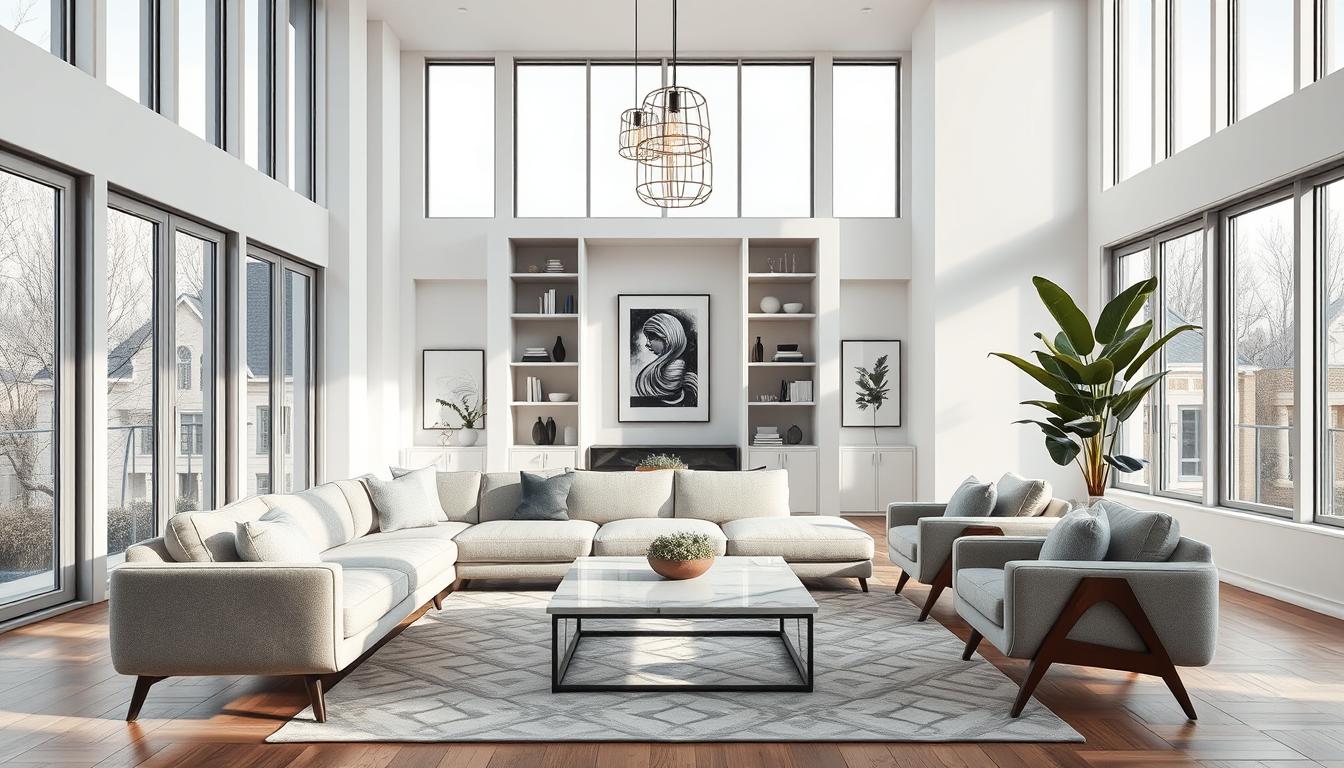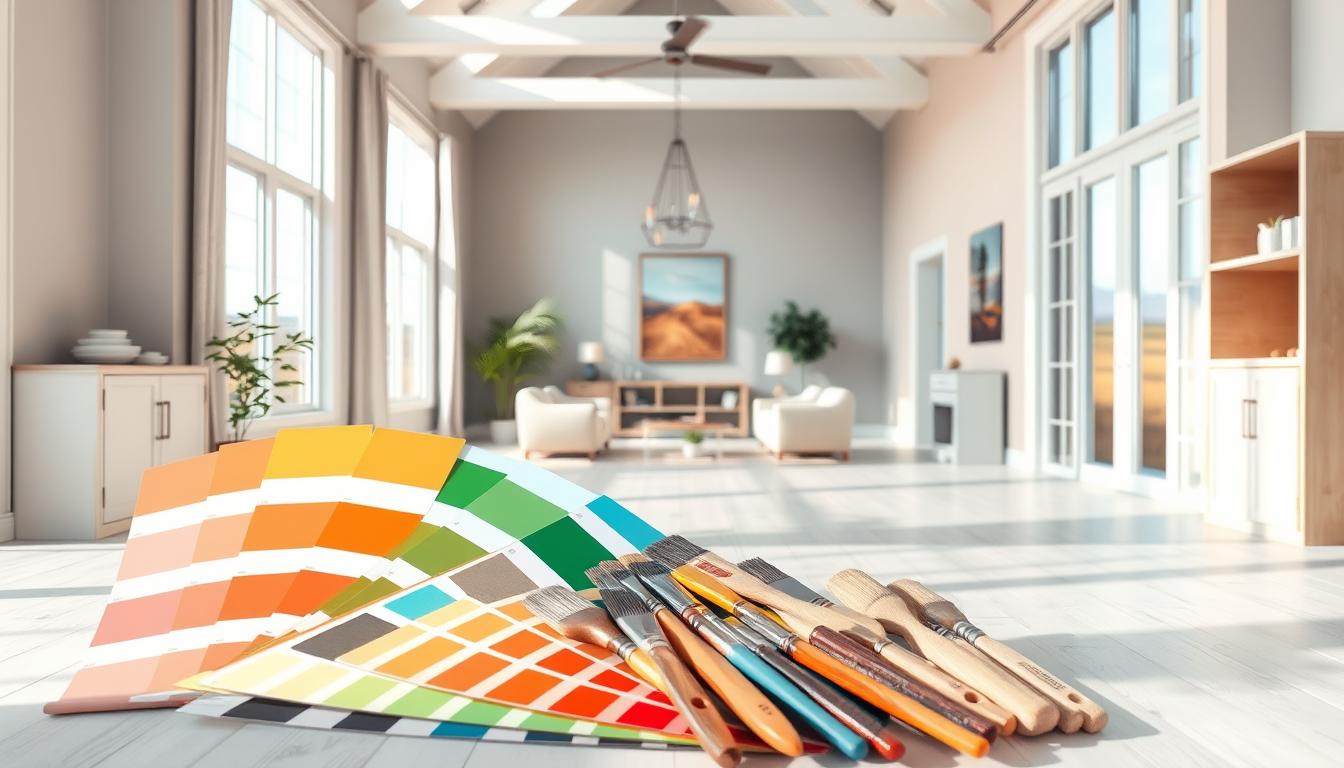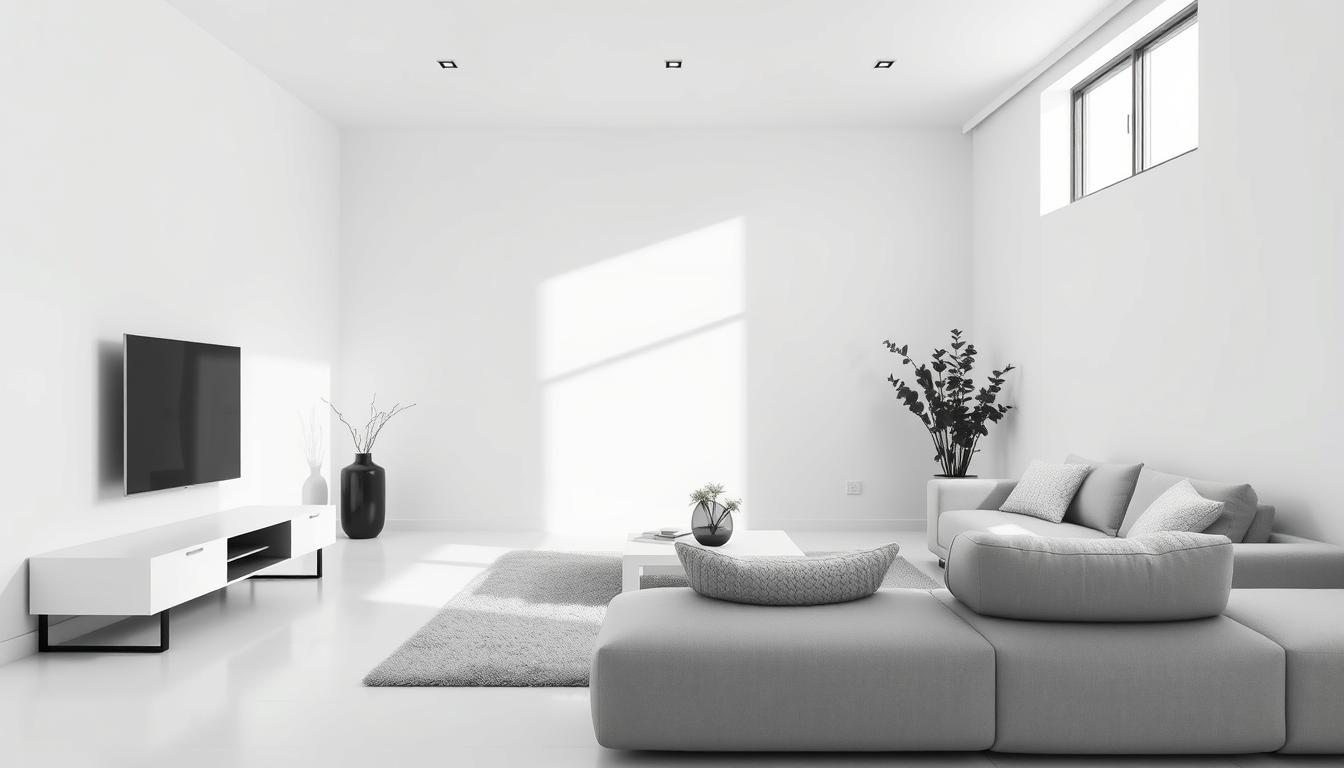As we enter 2023, it’s time to update our homes with the latest home decor trends. The world of interior design is always changing. Keeping up can be tough.
We’re excited to share our top picks for stylish and practical trends. These will turn your space into a cozy oasis. We’ll look at bold colors and sustainable living options that are big this year.
Key Takeaways
- Discover the top trends that will dominate 2023
- Learn how to incorporate bold colors into your space
- Explore sustainable living solutions for a greener tomorrow
- Find out how to create a functional and stylish oasis
- Get expert insights on staying ahead of the curve
Embracing Biophilic Design in 2023
In 2023, we’re seeing a big trend of bringing nature inside. This is thanks to biophilic design. It connects nature with our built spaces, making our homes better and more sustainable.
Importance of Nature in Interiors
Adding nature to our homes has many benefits. It lowers stress, improves air quality, and boosts creativity. This makes our homes calmer and more refreshing.
“Biophilic design is not just about adding plants to a room; it’s about creating a holistic environment that nurtures both body and soul.”
Using plants is a simple way to add biophilic design. They clean the air and make our spaces more beautiful.
Popular Plant Choices
Here are some top plants for biophilic design:
- Snake plants, known for their low maintenance and air-purifying qualities
- Peace lilies, which add a touch of elegance and help to remove toxins from the air
- Spider plants, easy to care for and great for hanging baskets
| Plant Type | Maintenance Level | Air Purifying Qualities |
|---|---|---|
| Snake Plant | Low | High |
| Peace Lily | Medium | High |
| Spider Plant | Low | Medium |
Incorporating Natural Light
Bringing in natural light is key to biophilic design. We can do this with big windows, skylights, or mirrors to spread light around.
By using biophilic design in 2023, we make our homes look good and feel good. It’s a great way to relax in our busy lives.
Sustainable Materials for Eco-Friendly Spaces
We’re moving towards a greener future, and using eco-friendly materials in homes is key. This change helps us reduce our environmental impact and make our living spaces healthier.
Types of Sustainable Materials
Sustainable materials are made and sourced in ways that are kind to the planet. Some top picks include:
- Bamboo: It grows fast and can be renewed easily.
- Recycled Metal: It cuts down on the need for mining and processing.
- Low-VOC Paints: They improve air quality by releasing fewer harmful chemicals.
Benefits of Using Recycled Products
Using recycled products in home design cuts down on waste and saves natural resources. For example, recycled glass countertops can greatly reduce the need for raw materials and lower carbon emissions.
| Material | Benefits | Applications |
|---|---|---|
| Recycled Glass | Reduces waste, conserves raw materials | Countertops, flooring |
| Reclaimed Wood | Preserves history, reduces deforestation | Furniture, flooring |
| Recycled Metal | Reduces mining, energy consumption | Decorative accents, fixtures |
Supporting Local Artisans
Supporting local artisans is vital in sustainable home design. Choosing local products cuts down on transportation emissions and boosts the local economy. For more ideas on stunning home interior design, check out our top 10 ideas for stunning home interior.
By using sustainable materials, recycled products, and supporting local artisans, we can make eco-friendly spaces. These spaces are not only beautiful but also help create a more sustainable future.
The Rise of Neutral Color Palettes
In 2023, we’re seeing a big comeback for neutral color palettes. They bring calm and elegance to our homes. Neutral tones are timeless and versatile, making them a favorite in interior design.
Shades of White and Gray
White and gray are key to a neutral color palette. They can cover walls, furniture, and decor, making a space look cohesive. Soft whites and creamy tones warm up a room, while cool grays add sophistication.
- Soft whites and creams for a warm ambiance
- Cool grays for a sophisticated look
- Warm beiges for a natural feel
Accents in Earth Tones
Adding earth tones as accents can really make a neutral space pop. Shades like terracotta, sienna, and umber can be used in furniture, rugs, and decor. They bring warmth and connect us to nature.
“The use of earth tones as accents can transform a neutral space into a cozy and inviting environment.”
Balancing with Textures
It’s important to balance neutral colors with textures for visual interest. Mixing textures like smooth, rough, matte, and glossy adds depth. For example, a smooth leather sofa with a rough rug and matte walls creates a rich atmosphere.
By using different textures and choosing neutral shades, you can make a space calm yet visually interesting. Neutral color palettes are great for showing off your style through furniture and decor.
Multifunctional Spaces in Urban Living
Urban living spaces are getting smaller. We must get creative with contemporary home design ideas. Our living areas need to be both useful and cozy.
In city homes, areas often have more than one use. A living room might also be a home office or guest room. We need multifunctional spaces that can change with our needs.
Making the Most of Small Areas
To use small areas well, we should pick space-saving furniture and smart storage. A storage ottoman, for example, can be a seat and a place to store things like blankets or toys.
Furniture that Adapts
Choosing furniture that can do more than one thing is crucial. Think about a sofa bed or a coffee table with storage. These items help keep things tidy and make a room more useful.
Zoning with Decor
To make different areas in a big space, we can use decor. A rug can mark a seating area, and a console table can divide a living space from a dining area.
By using these ideas in our home design, we can make multifunctional spaces that look good and work well.
Vintage and Antique Accents Revive Trends
Vintage and antique items are making homes more charming. They mix history with style. This trend is big in popular interior design styles today.
These accents add sophistication and character to modern homes. They connect the past with the present. This makes any room feel warmer and more interesting.
How to Mix Old and New
Mixing vintage and antique with modern decor needs care. Here are some tips for a good mix:
- Begin with a neutral background to highlight your vintage pieces.
- Choose a few standout vintage items instead of too many.
- Blend different textures and materials for depth and interest.
- Think about the era and style of your vintage items and how they match your modern decor.
Sourcing Unique Pieces
Finding the right vintage or antique piece is exciting. Here are some places to look:
- Local antique shops and vintage stores.
- Online marketplaces and auction sites.
- Estate sales and flea markets.
- Family heirlooms and items passed down.
Benefits of Vintage Decor
Using vintage decor in your home has many perks:
- Sustainability: Using vintage items reduces waste and supports green living.
- Uniqueness: Vintage pieces give your home a special touch that modern furniture can’t match.
- Storytelling: Each vintage item has its own history, adding a story to your home.
By carefully adding vintage and antique accents, you can make your home stylish and full of character.
Smart Home Technology Integration
Smart home technology is changing how we live. Our homes are becoming smarter, more responsive, and connected. This is thanks to these new innovations.
Must-Have Smart Devices
Choosing the right smart devices is key. Here are some essentials:
- Smart Speakers: Devices like Amazon Echo and Google Home let you control your home with your voice. It’s easy to change the mood and function of your home.
- Smart Thermostats: Thermostats like Nest learn your temperature likes. They adjust to keep you comfortable while saving energy.
- Smart Lighting: Brands like Philips Hue offer smart lights. You can control them from anywhere, setting schedules and changing colors.
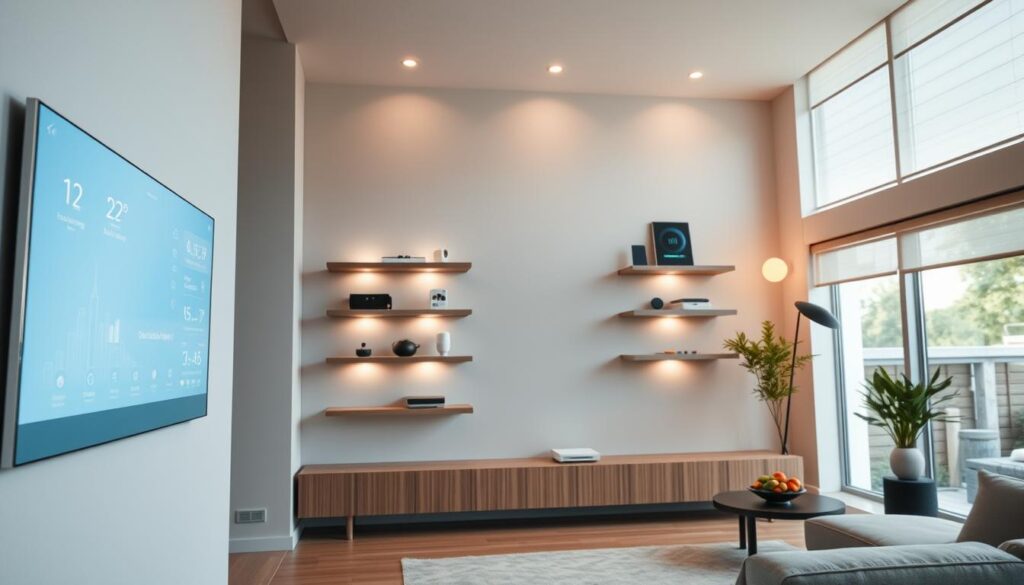
Enhancing Convenience and Comfort
Smart home tech makes our lives better. It adds convenience and comfort. For example, you can:
- Manage your home’s lights, temperature, and entertainment from one place or even from afar.
- Get updates on your home’s status, keeping you in the loop.
- Live in a more efficient home. Smart devices learn and adjust to your habits.
Tips for Seamless Integration
For smooth smart home integration, follow these tips:
- Start with a Hub: Begin with a central hub or controller. It makes managing your smart home easier.
- Consider Compatibility: Make sure devices work well together and with your home’s setup.
- Plan for the Future: Choose devices that can grow with you. This way, your investment stays relevant.
By using smart home tech wisely, we can make our homes more comfortable and convenient. They’ll also better meet our needs and preferences.
Layering Textures for Depth and Warmth
Layering textures is a key part of home decor. It adds complexity and visual interest to any room. By mixing different fabrics and materials, you can create a warm and inviting atmosphere that shows off the latest home decor trends.
Combining Fabrics and Materials
To layer textures, start by mixing fabrics like velvet, linen, and cotton. Use them for furniture upholstery, throw pillows, and blankets. For example, a velvet sofa with linen drapes and cotton throw pillows can make a living room look great.
Adding materials like wood, metal, and glass also enhances the layered look. A wooden coffee table with metal accents and glass vases can create a harmonious and textured space.
Color and Texture Harmony
It’s important to match colors with textures. Choose a color palette that goes well with the textures you want to use. For example, earthy tones like terracotta and sage green work well with natural textures like wood and woven fibers.
To avoid a cluttered look, balance bold textures with simpler ones. If you have a bold rug, pair it with simpler furniture upholstery. This balance makes the space feel cohesive and appealing.
Creating Cozy Environments
Layering textures is great for making cozy environments. Mix soft fabrics like throw blankets and plush rugs with natural materials like wood and stone. This creates a warm and inviting atmosphere, perfect for living rooms and bedrooms.
To make it even cozier, add warm lighting. Table lamps with soft shades can add a warm glow. This makes the space feel more intimate and relaxing.
Bold Patterns and Prints
Bold patterns and prints are now a big hit in home decor. They bring a fresh and exciting vibe to any space. We’ll look at the top patterns for wall art, how to use prints in fabrics, and how to mix bold with simple.
Popular Patterns for Wall Art
Wall art has endless options. Some top picks include:
- Geometric Patterns: These add a modern feel, from simple to complex shapes.
- Abstract Art: Great for a subtle yet striking look, adding sophistication.
- Botanical Prints: They bring nature indoors, perfect for decor.
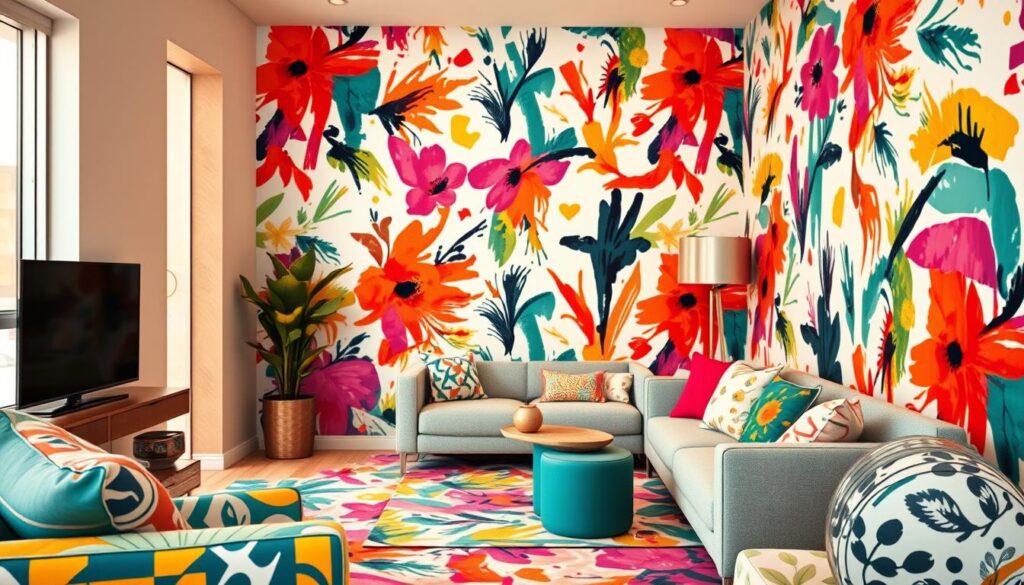
Utilizing Prints in Fabrics
Using prints in fabrics is another cool way to follow this trend. Here’s what to do:
- Put bold prints on items like throw pillows or blankets for a color and texture boost.
- Choose subtle patterns for bigger items like upholstery to keep things balanced.
- Try mixing different prints for a unique, personalized look.
Balancing Boldness with Simplicity
It’s key to balance bold patterns with simplicity. This avoids overwhelming the space. Here’s how:
- Pair bold patterns with neutral backgrounds for contrast.
- Don’t overdo it with bold elements in one room for harmony.
- Use simple furniture designs to balance out bold patterns.
By mixing bold patterns and prints with simplicity, you can make a stylish and welcoming space. This trend is here to stay, offering endless ways to be creative and express yourself.
Outdoor Living Spaces as Extensions of Home
Outdoor areas are becoming a big part of our homes. We want to make our living spaces more livable and fun. This means blending indoor and outdoor areas smoothly.
Designing Functional Patios and Decks
Functionality is key when designing outdoor spaces. A good patio or deck makes your outdoor area more useful. Add outdoor kitchens, fire pits, and comfy seating to make it welcoming.
Key Considerations for Functional Outdoor Spaces:
- Think about the layout and size of your outdoor area.
- Choose furniture and decor that can stand up to the weather.
- Use lights to make your outdoor space usable at night.
Outdoor Furniture Trends
The right furniture is essential for outdoor spaces. Today, we look for furniture that’s stylish, durable, and comfy. Opt for pieces made from recycled plastic or wood that’s good for the planet.
| Furniture Type | Material | Trend |
|---|---|---|
| Sectional Sofas | Wicker/Rattan | Cozy, inviting configurations |
| Dining Sets | Recycled Metal | Sustainable, eco-friendly |
| Loungers | Polypropylene | Durable, weather-resistant |
Enhancing Privacy in Outdoor Areas
Privacy is key to enjoying your outdoor space. You can use plants, privacy fences, or outdoor curtains to keep things private.
Effective Ways to Enhance Privacy:
- Plant tall shrubs or trees around your outdoor area.
- Put up a privacy fence or screen to block views.
- Use outdoor curtains or drapes to create private spots.
Designing your outdoor space well can make it a great extension of your home. It can be a place to relax, entertain, or just enjoy the outdoors. A well-designed outdoor space can really improve your life.
The Continued Popularity of Minimalism
Looking at the top home interior design trends for 2023, minimalist design is still a favorite. It’s not just simple; it’s about making a space calm and useful.
Core Principles
Minimalist design is all about a few main things: clean lines, few decorations, and a simple color scheme. These help make a home feel calm and clear.
Effective Space Planning
Good space planning is key in minimalist design. By planning a room’s layout well, even small spaces can feel bigger and more open.
Serenity Through Simplicity
Minimalist design is all about finding peace in simplicity. By removing clutter and focusing on what’s important, homes become peaceful places. This design style keeps inspiring people to change their living spaces.

